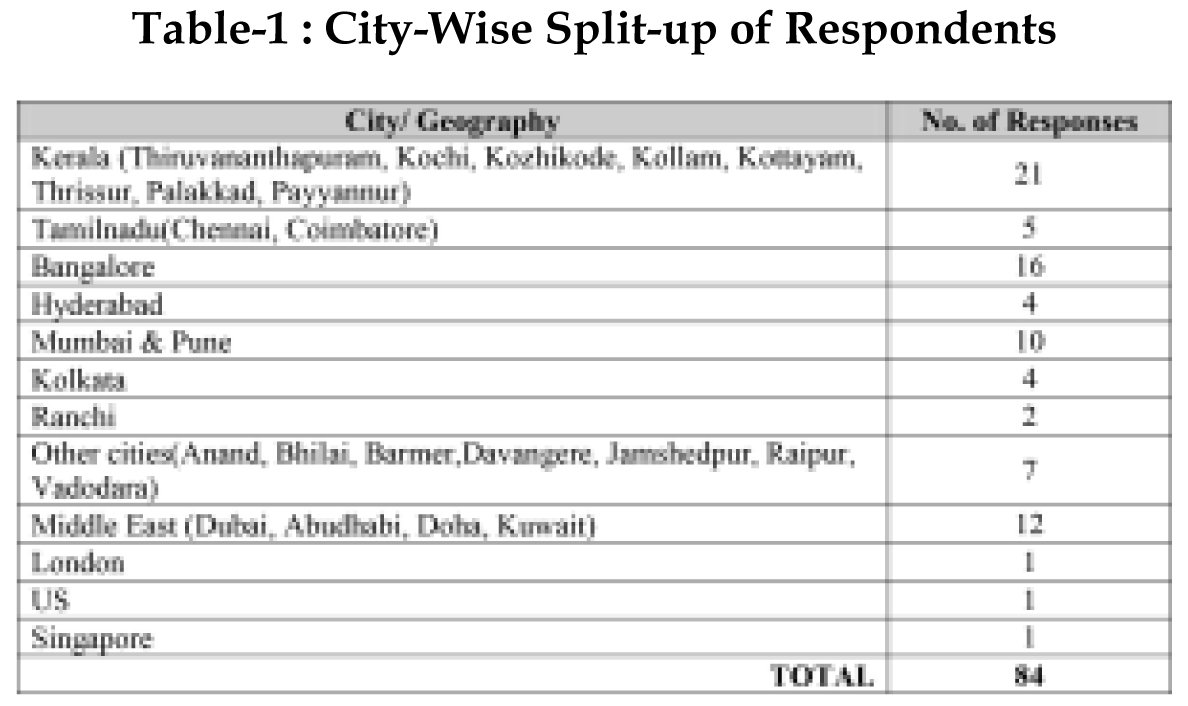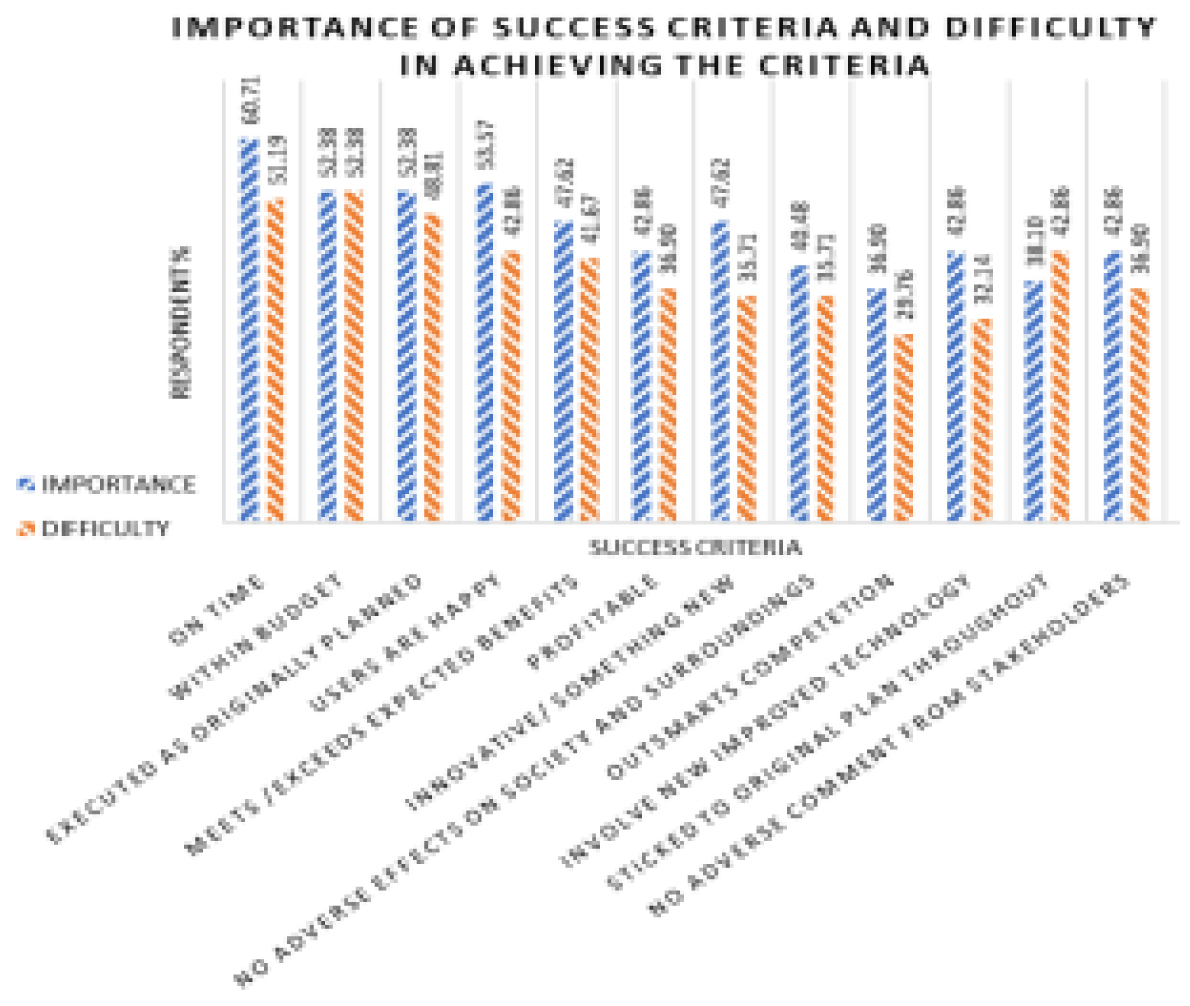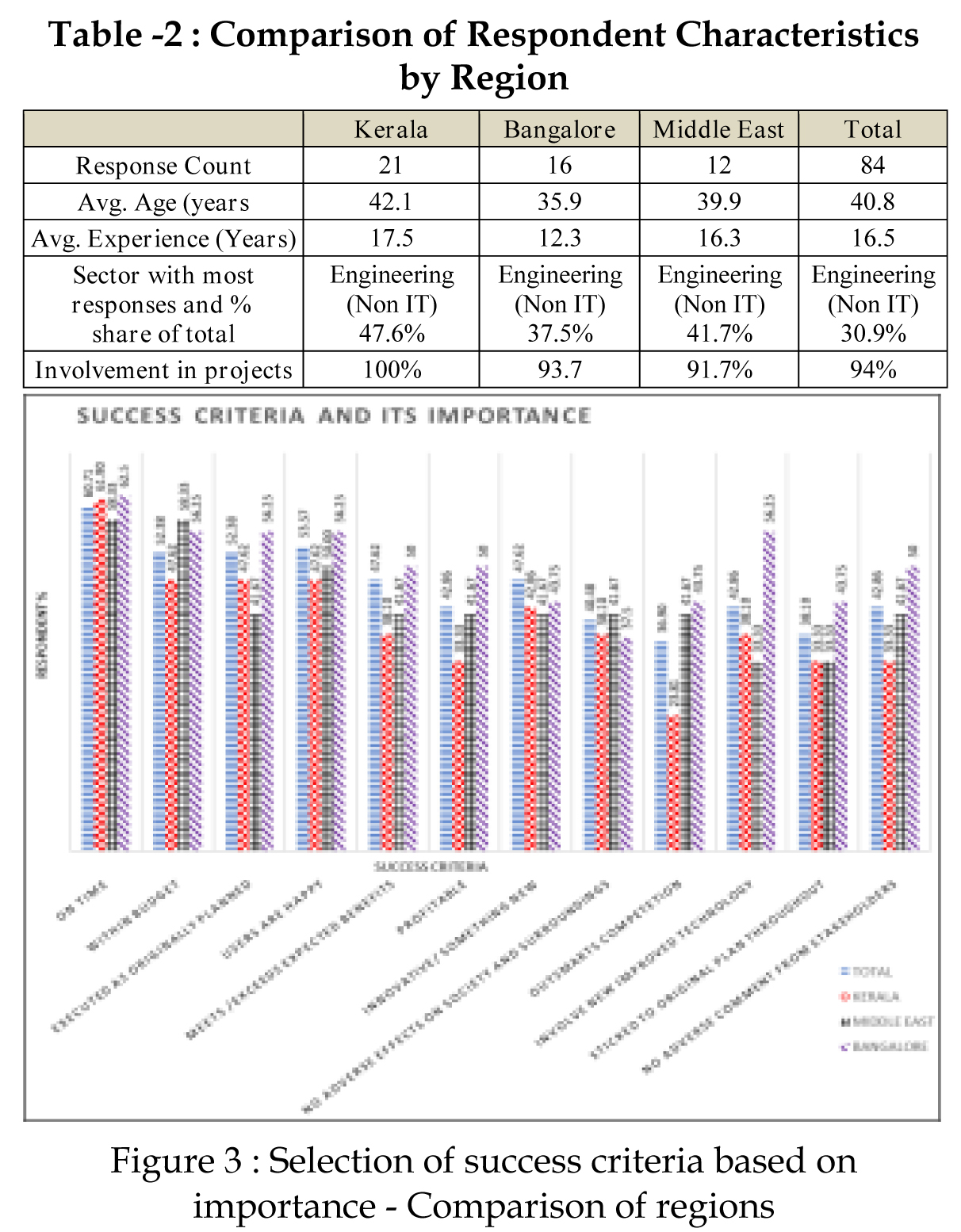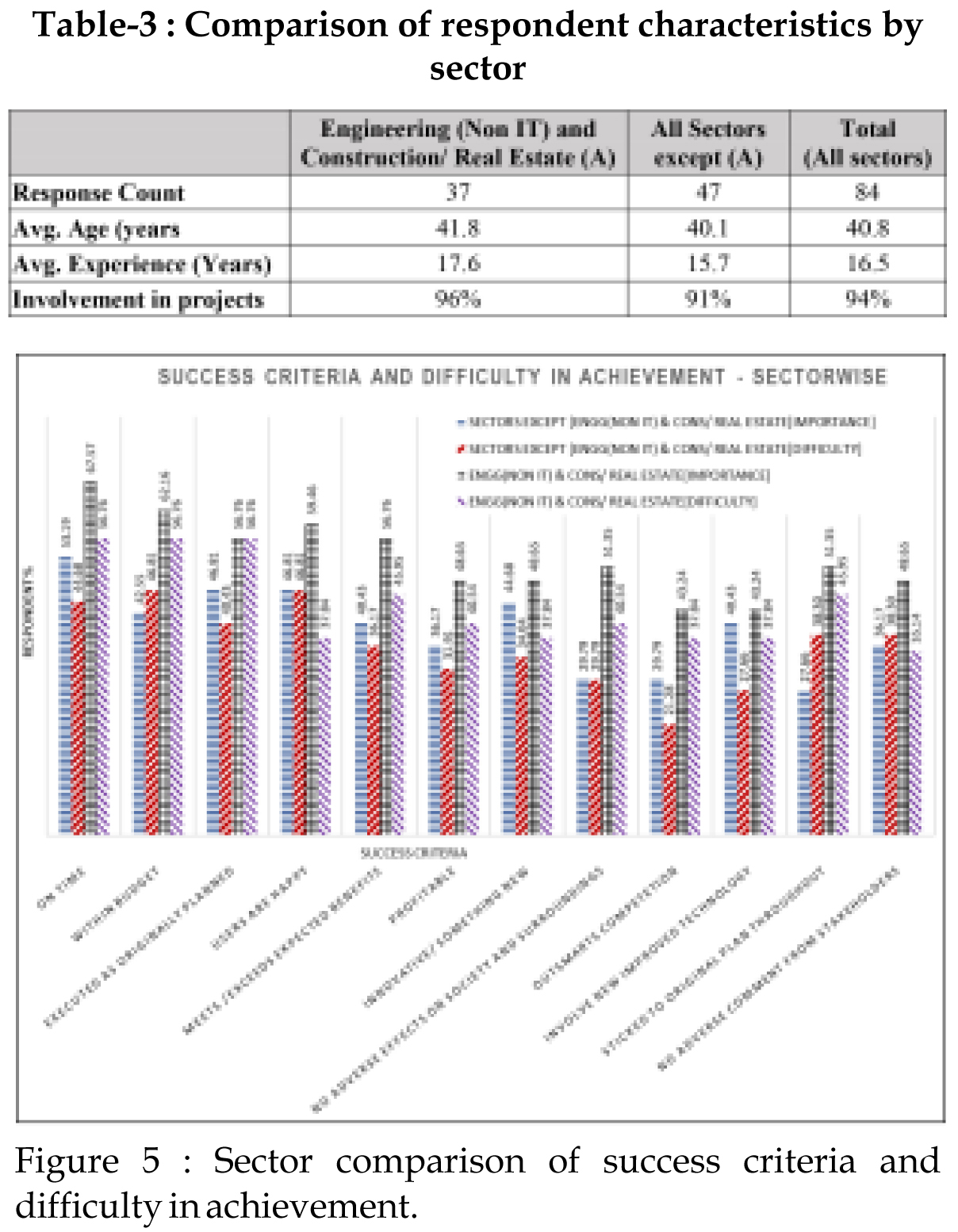Subscribe now to get notified about IU Jharkhand journal updates!
Project Success Criteria Preferences
Abstract :
Research on projects and their success have pondered on many dimensions related to the management of projects in various sectors and the resultant outcomes. Project success studies concentrated on management systems in place for projects as well as the benefits realized due to projects and programs. Project success in the perspective of various stakeholders differs from each other and this is largely due to the success criteria each consider while evaluating/ judging the success of projects. This study is a pilot that tries to capture the preferences of workforce related to success criteria for projectsin their respective work areas.
Keywords :
Project Success, Project management success, Success factors, Success criteria, Performance measurementIntroduction :
This paper draws inspiration from Atkinson's paper titled
“Project management: cost time and quality two best
guesses and a phenomenon, it's time to accept other
success criteria” (Atkinson, 1999) which dwells on the
need to adopt additional success criteria for projects than
just the major three criteria generally referred as the 'Iron
Triangle' – time, cost, quality and eventually puts forward
a method called the “square route” with additional
considerations towards project success criteria.
This paper forms part of the Ph.D. research on success
factors in planning of infrastructure projects and is an
initial portrayal of the preferences of project professionals
in India about success criteria in projects.
Project Success and Project Management Success
Project success as a topic of research was studied for the past few decades. (Baker, Fischer, & Murphy, 1974) studied effectiveness of projects to determine those factors which affect project performance and to distinguish between those factors which improve success and those which cause failure. The notion during early years was that if the project finished on time, near the budget cost and performed as envisaged, it was considered successful. Considerations like client satisfaction came into picture later (Pinto & Slevin, 1988). Researchers all over the world have differentiated project success from success of project management process and pointed to the fact that an overall success in the project management process does not ensure a successful project and that poor performance in terms of project management performance measurement need not indicate a project failure (de Wit, 1988; Munns & Bjeirmi, 1996) . Baccarini states that project management success is measured in terms of internal factors (cost-time-quality) whereas achieving product success is concerned with project's external effectiveness. Product success is of higher order, project management success is subordinate to product success. (Baccarini, 1999). Delivering project Sarosh Kothandath1 success is more difficult than delivering project management success. Goals and methods are liable to change whereas project management success is based on predetermined goals (Cooke-Davies, 2002)
Success Criteria and Success Factors
Success criteria refer to the measurement of project
success whereas success factors refer to the those inputs to
management system that lead directly/ indirectly to the
success of project/ business. (Cooke-Davies, 2002).
Critical success factors are those few things that must go
well to ensure success for a manager or an organization ...
(Boynton & Zmud, 1986). Critical Success Factors (CSFs)
are the limited number of areas in which satisfactory
results will ensure successful competitive performance for
the individual, department or organization. CSFs are the
few key areas where “things must go right" for the
business to flourish and for the manager's goals to be
attained. (Bullen& Rockart, 1981)
Project performance over the years is habitually measured
in terms of the management factors referred to as “iron
triangle” comprising cost, time and quality factors
(Atkinson, 1999). Many researchers have pointed out the
role and use of these criteria in the management of project
execution and also highlighted the cons of using these
criteria alone as a means of project success measurement.
Hard factors like cost, time, quality are relatively easy to
measure. Soft factors like happiness, job satisfaction,
enhanced reputation are subtle and difficult to measure.
(Baccarini, 1999).
Success of project means different things for different
people (Shenhar, Dvir, Levy, & Maltz, 2001). Different
stakeholders based on their interests/ involvement in the
project during particular project phases have their own
views on success of the project,
Some researchers suggested that project success criteria
should be specific to each project and that they should
therefore be determined by stakeholders at the start of
each project. Critical Success Factors are those components
that are necessary to deliver the success criteria and can be
described as the set of situations, factors or actions that
contribute to the final results or the achievement of success
criteria (Gomes & Romão, 2016).
Methodology and Analysis
Project Success Criteria obtained from literature and
authors' own experience in public infrastructure projects
formed the basis for choosing the twelve success criteria
which were included in the study. An online
questionnaire-based survey was conducted, the
respondents targeted were employees in their mid-career
level for various industry segments with experience
above10years in their respective work streams.
Convenience sampling was adopted for collection of
responses and eventually it was observed that few
respondents were having lesser experience. Data on
success criteria with respect to the perceived importance
and perceived difficulty in achieving the criteria was
collected from the respondents and analysis of preferences
for success criteria among respondents is included here.
Success criteria that were considered for the survey are :
- Projects are completed on-time or ahead of time (Time)
- Projects are completed within budget (Cost)
- Projects is executed as originally planned (Scope)
- Customers/users are happy about the project (Customer satisfaction)
- Project meets/ exceeds the expected benefits (Benefit Assessment)
- Project is profitable (Profitability)
- Project is innovative/ brings something new (Innovation)
- Project does not have any adverse effects on society and surroundings (Environmental and Social safeguards)
- Project outsmarts competition (Uniqueness)
- Project involved use of new/ improved technology (Technology focus)
- Project sticked to its original plan throughout the timeframe (Variations)
- There are no adverse comments on the project from any of the stakeholders (Stakeholder coordination/ Stakeholder integration)
A total of 84 completed responses were obtained, partially
completed responses were separated out prior to the
analysis. Respondents belong to various industry sectors,
currently employed at different hierarchical levels in their
organisations. Respondents were mostly from South India
which also included expatriate professionals belonging to
the region while few responses received from other cities.
The geographical breakup of respondents is provided
Table – 1 below:

Information from respondent profile shows that average
age is 40.8 years and average years of experience of 16.5
years. An industry split-up of the respondents is shown in
Figure 1 below, the data shows that there are respondents
from a minimum of 12 industry sectors of which
Engineering (Non IT) sector has the maximum of about
31% respondents. A maximum of 33% respondents have
identified themselves as professionals while managers
account for 23% and consultants/ advisors 15%. Among
them, all managers and consultants have expressed
involvement in projects whereas 93% of respondents
categorised as professionals involved in projects. Overall,
there is 94% involvement in projects.

The questionnaire enabled respondents to select their
choice of success criteria from the provided list of 12
criteria and also to select those success factors which they
feel are more difficult to achieve. In addition, a qualitative
rating for the level of importance and level of difficulty for
the selected success criteria on a three-point scale was also
gathered. As shown inFigure-2 below, it can be seen that
on-time completion (61%) is selected as the most
important success criteria followed by within budget,
execution as planned and user satisfaction (all the three in
the range 52%-53%) whereas in terms of difficulty in
achievement, both on-time completion and within budget
are selected as critical by maximum number of
respondents. In addition, other success criteria like user
satisfaction, meeting expected benefit and innovation are
also given some focus.
Figure-2 below shows a plot of the success criteria selection
along with perception on the difficulty in achieving
success with respect to the particular criteria, it can be
observed that the preference towards the success criteria
by the respondents and their assessment of difficulty for
achievement of the particular criteria shows a similar
trend. A relation between the two variables is a possibility
based on the available variation pattern. The present study
explores the basic preferences on success criteria and
therefore is not in a position to comment on this aspect. It is
expected that further analysis on the same could throw
some light.
 Figure 2 : Selection of success criteria based on importance
and difficulty
Figure 2 : Selection of success criteria based on importance
and difficulty
Regional preferences for success criteria
A comparison on the collected data on a regional basis was
carried out. From Table-1 above, we can see that 25% of the
respondents are from Kerala (21 Nos), 19% respondents
from Bangalore (16 Nos) whereas 12 respondents (14%)
from Middle east cities (Dubai, Abudhabi, Doha and
Kuwait). The selection also assumes significance
considering that respondents from Kerala are from smaller
cities/ towns which could be considered as semi-urban
whereas both Bangalore and Middle east cities are
categorised as world cities(Sassen, 1991). Table-2 below
gives a comparison of the basic respondent characteristics.
It could be seen that a comparatively substantial
representation from Non IT engineering professionals in
the sample considering the total sample as well as regional
split-up (> 30 % overall and upto 47% for Kerala). This
suggests that the success criteria selection could possibly
have a bias towards Engineering (Non IT) projects. The fact
that the present study is intended to aid the' research on
p r o j e c t s u c c e s s i n i n f r a s t r u c t u r e p r o j e c t
planning(Kothandath, 2017)could possibly add another
reason for the biased sample.

A plot of regional comparison with regards to the selection
of success criteria and perceived difficulty in achieving the
particular criteria for the four regions in Table 2 is
provided in Figure 3 and Figure 4 respectively. 'On time
completion' is selected as the most important criteria in all
the regions followed mostly by 'within budget' and 'user
satisfaction', a general similarity in preferences is found
along with some unique preferences. For instance, a clear
preference towards 'user satisfaction' and 'new
technology' can be found for Bangalore.

Sectoral preferences for success criteria
A comparison of the characteristics and success criteria
preferences for the main sector to the other sectors
combined was carried out to explore any major visible
differences. In this analysis, major sector considered is
samples from Engineering (Non IT) and Construction/
Real Estate sectors put together with a total of 37 responses.
Other sectors combined accounts for the balance 47
responses. Table 3 compares the basic characteristics of the
two categories along with the overall data.

A comparison of the preferences for the sectors is plotted in
Figure 5, the first two columns in the chart for importance
of success criteria and corresponding difficulty in
achievement for other sectors and the third and fourth
columns representing importance of success criteria and
corresponding difficulty for the main (Engg.+
Construction) sector. The chart shows substantial
difference in the levels for both the variables across all the
12 success criteria. More importance to the success criteria
in the major sector is indicated by the comparatively higher
preference whereas for the other sectors relative
importance is less for most of the criteria. 'On time
completion' and 'user satisfaction' are the two important
criteria for the other sectors. A similar variation is observed
in the difficulty level assessment. Another observation is
that despite the substantial difference in preferences
between the sectors, there is good similarity between the
responses for importance of success criteria and difficulty
in achievement i.e., Columns 1 and 2 have a similar trend,
similar is the comparison for Column3 and Column 4. The
perception on importance of the success criteria and its
difficulty level follows a similar pattern in the overall as
well as regional and sectoral analyses suggesting the
possibility of a relation between the two. However, the
current analysis is not in a position to suggest on this,
further study will be required to explore this aspect
It could be argued that success criteria considerations are
of a wider spectrum in physical infrastructure projects
whereas in comparison, success could be judged
reasonably well using the one or two most important
criteriain other sectors. The findings also go in line with the
widely accepted fact that physical infrastructure projects
are relatively complex. (Godau, 1999; Jajac, Knezic, &
Marovic, 2009; Koops, Coman, Bosch-Rekveldt, Hertogh,
& Bakker, 2015)
Results
A total of 84 usable responses received from more than 250 prospective respondents to whom questionnaire posted including 21 from Kerala, 16 from Bangalore, 10 from Mumbai and Pune and 15 from expatriates of which 12 from Middle east. Engineering (Non IT) sector has the maximum of 31% respondents. 33% respondents are professionals, managers are 23% and consultants/ advisors 15%. 94% have expressed project involvement. 'On time completion' is chosen as the most important criteria overall, the same is found true for region wise analysis and sectoral analysis. A general similarity in preferences is found in regional analysis with some unique preferences like preference towards 'user satisfaction' and 'new technology' found for Bangalore. Substantially higher preference for success criteria observed in the major sector in comparison to other sectors combined.
Conclusion
Higher preferences to time and budget criteria across sectors and geographies is observed and points to more focus being given to project management process and operational aspects instead of project benefits and success (Shenhar et al., 2001). Sectoral comparison of perception for success criteria is in line with general belief regarding complexity for physical infrastructure projects and its preference for more success criterion. A possible close relation between preference for a success criterion and its perceived difficulty to achieve is found, the present analysis not sufficient to confirm the same and hence further analysis needed on this aspect.
Bibliography
